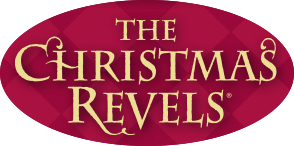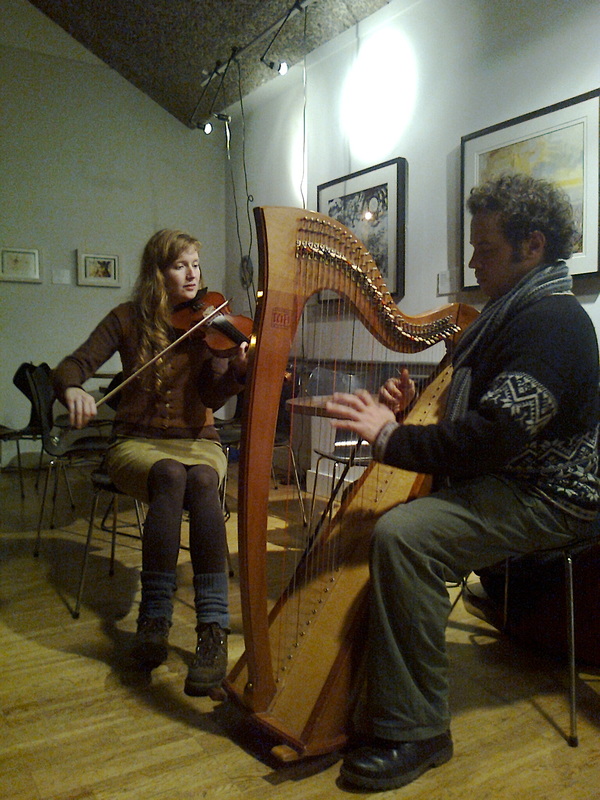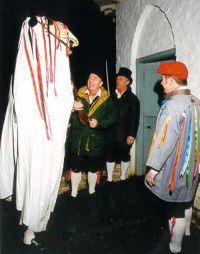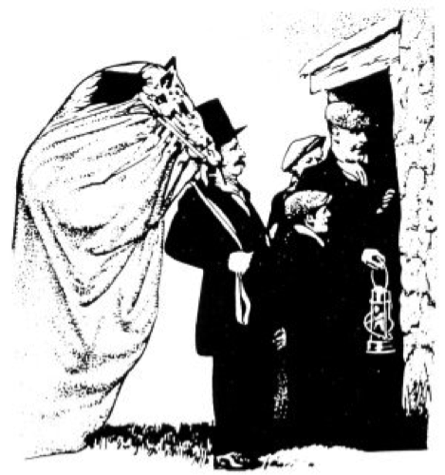For Thursday, December 8Snacks: Sopranos
Elsa and Ceri will be on CityLine Thursday morning at 9:30 on TV Tacoma.
TV Tacoma is carried on both the Click! and Comcast Cable systems. On Click! TV Tacoma can be seen on Channel 12 in the Tacoma City limits and in Pierce County, with the exception of University Place, where we are found on Channel 21. On Comcast, TV Tacoma can be seen on Channel 12 in the Tacoma City limits and on Channel 21 in Pierce County. We are NOT carried on the Comcast system in University Place. Replay times on TV Tacoma: Monday - 11 AM and 6 PM Tuesday - 2 AM, 8 AM, 2 PM, and 7 PM Wednesday - 4 AM and 11 AM Thursday - 9 AM (Live) and 7 PM Friday - 1 AM, 8 AM, and 9 PM Saturday - 2 AM, 1 PM, and 7 M Sunday - 10 AM, 2 PM, and 11 pm You can also watch online Mari Lwyd Score-- I transcribed the basic melody to help clarify and speed this process. I did not include every ornament and rhythmic snap, but I did note some pitch alterations between the verses which Elsa used.
We'll be learning the welcome song from this recording and words. Pick a part and go for it!
|
Revels
|
Elsa Davies and Ceri Owen Jones
|
Recordings
These are provided as an general aid to learning music quickly, but may not be exactly as we will perform them.
Use them for reference, not as a paradigm.
vs. 1 Let us awake, awake, and let us give praise
Before the break of day,
To the divine heir of the heavenly country
A welcome there is;
The stars of the morn of the world sang,
That is, all the angels of God together,
All the Prophets sang,
Without being false;
And why should we not sing as one
About getting great Jehovah himself
In manner like man and in his image
Truly to heal us.
vs. 2
More on the Mari Lwyd From Ceri and Elsa
The exchanges between the outside group and the inside group are in rhymed verse (the type of measure used for the Mari Lwyd is called 'Tri Thrawiad'). This is an example of the song we sang for Megan (the verse is 12.9. (i.e. a line of 12 syllables and then a line of 9 syllables - rhyme scheme aAaB)):
Wel, dyma ni'n dwad (6) Cyfeillion diniwad (6) = 12 I ofyn am gennad (6) i ganu (3) = 9 [Well, here we are coming / innocent friends / to ask for permission / to sing] The way each verse is sung is to sing the first two lines as a phrase, then repeat; sing the third line, three times, and then the last line once to close. The tune we have is from Ceinewydd (the village where we live). We'll do recordings to send onto Megan. The verses tend to be the outside group asking to come in, for food & drink, and the inside group trying to deter them. Generally, the proceedings would be very raucous though maybe not too rude. Sometimes the verses of both groups poke fun at each other. Usually it is men on the outside with the Mari, and families on the inside with the food. Once inside, there would be ale and food and more singing (including a song thanking everyone) but the Mari Lwyd was in the past also a way to raise money for the poor, as the group would collect money from the houses they visited. Elsa's mom remembers the Mari Lwyd visit as being very scary - the Mari (horse's skull) was quite a threatening figure. These days the Mari procession goes between pubs rather than people's houses. There is a leader for the horse, holding his reins, and the Fari will sometimes try to bite people. In Mallwyd they also have a parson character, wearing ribbons on his arms, and a Beca figure (a man in women's dresses), and everyone in the group wearing ribbons. In Ceinewydd, our village, they used to have a lot of ribbons on the Fari, and included a procession of people wearing homemade animal masks to accompany, like foxes & squirrels. Calennig is a New Year's morning visit by children around the local houses - singing special rhymes, and collecting money - nowadays they collect the money to send to local charities. The rhyme the children used to say in our area was 'Calennig yn gyfan, ar fore dydd Calan, unwaith, dwywaith, tair!' [A whole New Year's present on the morning of New Year's Day, once, twice, three times!] |
From our friends atThe Grey Ghost Horse The year has rolled round again, and we’re halfway between the Autumnal Equinox and the Winter Solstice. Given where we live, we couldn’t say the frost is on the pumpkin, but the pumpkin is certainly on the porch and grinning a toothy greeting to hordes of itinerant revelers. It must be Halloween, or Samhain as it was called in the ancient Celtic world. It is the time when the veil grows thin between this world and the afterlife and the spirits of the departed can cross over. While we don’t celebrate Samhain in the Christmas Revels, there is a Welsh custom that we’ll be observing this year that could well put you in mind of Halloween. I’m referring to the Mari Lwyd, or Grey Mare, a tradition reminiscent of Wassailing or Mumming, where a troupe of costumed roisterers goes from house to house (or pub to pub), asking for food and drink, singing and matching wits with the inhabitants. What makes the Mari Lwyd distinctive is the presence of a ghostly character represented by a horse’s skull mounted on a pole, carried by a white-sheathed bearer. Mick Tems of the Llantrisant Folk Club describes the custom like this: “Y Fari Lwyd (translated as the Grey Mare, or The Grey Mary) and her group go from house to house and pub to pub and try to gain access by performing a series of verses, or ‘pwnco’. The inhabitants would reply with their own verses in a battle to outwit Mari and her gang and prevent her from entering. Eventually she will be let in, as this confers luck on the household for the coming year and scares out anything unwanted from the previous year. Once inside, more songs are sung and the group is given drinks and food. Mari often becomes quite mischievous and takes particular fancy to any young women there, chasing them and generally causing trouble.” But why a horse’s skull? Where did that come from? Tems observes, “The tradition of Y Fari Lwyd has certain pre-Christian origins. In Celtic Britain, the horse was seen as a symbol of power and fertility and prowess on the battlefield. In Celtic mythology, animals who had the ability to cross between this world and the underworld (the Celtic Annwn) are traditionally white or grey coloured. Arawn, King of Annwn’s dogs, are white with red ears and he rides on a large grey horse.” Like so many customs, the particulars of this one have evolved over time. While nobody knows precisely when it started, or how it was originally performed, we do know that by the early 1900’s, the Mari itself consisted of a real horse’s skull with glowing eyes and a snapping lower jaw, and that the party that accompanied her included a Leader, a Sergeant, a Merryman and Punch and Siwan (Punch and Judy from the Commedia tradition). We also have verses of the pwnco that were sung, preserved by a censorious clergyman as an example of degenerate primitive custom. All of these elements - characters, songs and skull - will appear in our Welsh village in just a few weeks as we celebrate a Revels Christmas in Wales.
Part Assignments(This is fluid. Let me know if this is not what we said, or if it needs to change.)
|





